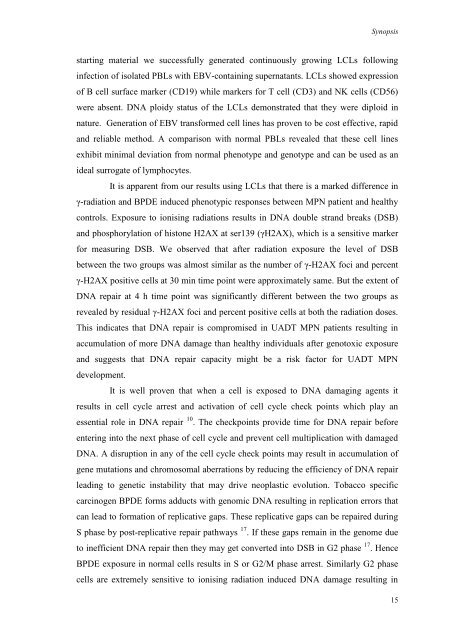LIFE09200604007 Tabish - Homi Bhabha National Institute
LIFE09200604007 Tabish - Homi Bhabha National Institute
LIFE09200604007 Tabish - Homi Bhabha National Institute
You also want an ePaper? Increase the reach of your titles
YUMPU automatically turns print PDFs into web optimized ePapers that Google loves.
Synopsis<br />
starting material we successfully generated continuously growing LCLs following<br />
infection of isolated PBLs with EBV-containing supernatants. LCLs showed expression<br />
of B cell surface marker (CD19) while markers for T cell (CD3) and NK cells (CD56)<br />
were absent. DNA ploidy status of the LCLs demonstrated that they were diploid in<br />
nature. Generation of EBV transformed cell lines has proven to be cost effective, rapid<br />
and reliable method. A comparison with normal PBLs revealed that these cell lines<br />
exhibit minimal deviation from normal phenotype and genotype and can be used as an<br />
ideal surrogate of lymphocytes.<br />
It is apparent from our results using LCLs that there is a marked difference in<br />
γ-radiation and BPDE induced phenotypic responses between MPN patient and healthy<br />
controls. Exposure to ionising radiations results in DNA double strand breaks (DSB)<br />
and phosphorylation of histone H2AX at ser139 (γH2AX), which is a sensitive marker<br />
for measuring DSB. We observed that after radiation exposure the level of DSB<br />
between the two groups was almost similar as the number of γ-H2AX foci and percent<br />
γ-H2AX positive cells at 30 min time point were approximately same. But the extent of<br />
DNA repair at 4 h time point was significantly different between the two groups as<br />
revealed by residual γ-H2AX foci and percent positive cells at both the radiation doses.<br />
This indicates that DNA repair is compromised in UADT MPN patients resulting in<br />
accumulation of more DNA damage than healthy individuals after genotoxic exposure<br />
and suggests that DNA repair capacity might be a risk factor for UADT MPN<br />
development.<br />
It is well proven that when a cell is exposed to DNA damaging agents it<br />
results in cell cycle arrest and activation of cell cycle check points which play an<br />
essential role in DNA repair 10 . The checkpoints provide time for DNA repair before<br />
entering into the next phase of cell cycle and prevent cell multiplication with damaged<br />
DNA. A disruption in any of the cell cycle check points may result in accumulation of<br />
gene mutations and chromosomal aberrations by reducing the efficiency of DNA repair<br />
leading to genetic instability that may drive neoplastic evolution. Tobacco specific<br />
carcinogen BPDE forms adducts with genomic DNA resulting in replication errors that<br />
can lead to formation of replicative gaps. These replicative gaps can be repaired during<br />
S phase by post-replicative repair pathways 17 . If these gaps remain in the genome due<br />
to inefficient DNA repair then they may get converted into DSB in G2 phase 17 . Hence<br />
BPDE exposure in normal cells results in S or G2/M phase arrest. Similarly G2 phase<br />
cells are extremely sensitive to ionising radiation induced DNA damage resulting in<br />
15

















